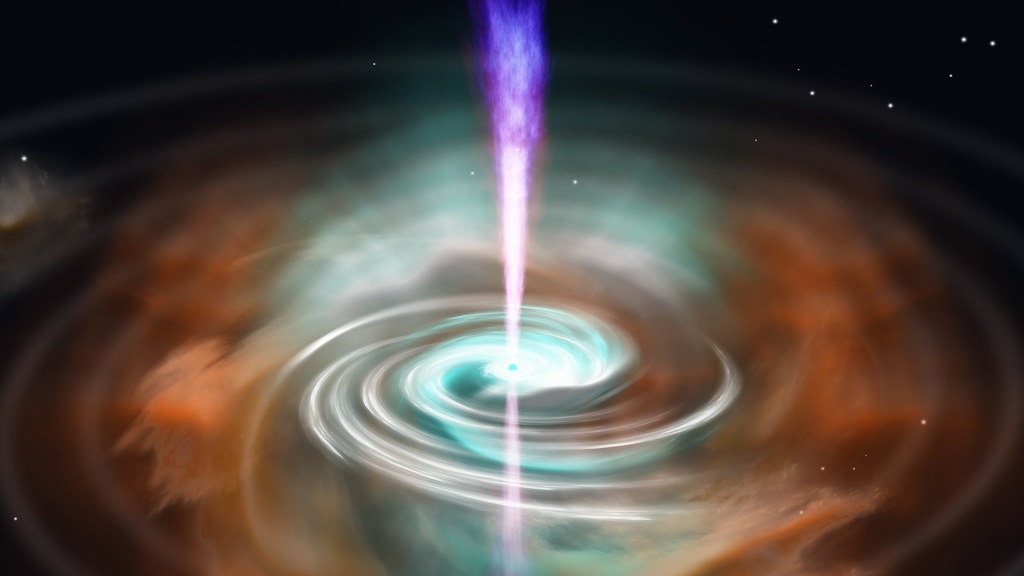Reviewed by Alex SmithNov 14 2022
Gamma-ray bursts (GRBs), which are bright flashes of the most energetic gamma-ray radiation lasting a few milliseconds to several seconds, have been discovered by satellites orbiting the Earth. These devastating blasts take place in galaxies billions of light years away from Earth.
 An artist’s impression of a gamma-ray burst powered by a neutron star. Image Credit: Nuria Jordana-Mitjans
An artist’s impression of a gamma-ray burst powered by a neutron star. Image Credit: Nuria Jordana-Mitjans
When two neutron stars collide, a short-duration GRB, a subtype of GRB, is born. The mass of the Sun is compressed into these incredibly dense stars, which are half the size of London, and they produce gravitational waves in the final moments of their lives, just before triggering a GRB.
Up until now, the majority of space scientists have concurred that the “engine” driving such powerful but brief bursts must always originate from a newly formed black hole which is a region of space-time where gravity is so intense that even light cannot escape from it.
This scientific consensus is being questioned by new research conducted by an international team of astrophysicists under the direction of Dr. Nuria Jordana-Mitjans at the University of Bath.
The results of the study suggest that some short-duration GRBs are not caused by black holes but rather by the birth of supermassive stars, also known as neutron star remnants.
Such findings are important as they confirm that newborn neutron stars can power some short-duration GRBs and the bright emissions across the electromagnetic spectrum that have been detected accompanying them. This discovery may offer a new way to locate neutron star mergers, and thus gravitational waves emitters, when we’re searching the skies for signals.
Dr Nuria Jordana-Mitjans, Research Associate, Department of Physics, University of Bath
Competing Theories
Short-duration GRBs are well-understood. When two neutron stars that have been accelerating and spiraling closer together finally collide, they begin to function. A jetted explosion at the crash site also emits the gamma-ray radiation that creates a GRB, which is then followed by a more persistent afterglow.
The radioactive material that was ejected in all directions during the explosion created what is known as a kilonova a day later.
However, there has long been controversy over exactly what is left over when two neutron stars collide. This is known as the “product” of the crash, and it is this product that provides a GRB with extraordinary energy. The results of the Bath-led study could well have brought this debate closer to an end for scientists.
Two theories are being debated by space scientists. According to the first theory, neutron stars briefly merge to form an incredibly massive neutron star before it instantly disintegrates into a black hole. The second claims that the merger of the two neutron stars would produce a less dense neutron star with a longer lifespan.
The age-old conundrum that has plagued astrophysics for decades is whether the origin of short-duration GRBs lies in the birth of a long-lived neutron star or a black hole.
Most astrophysicists up to this point have favored the black hole theory, concurring that a GRB can only be created if the massive neutron star collapses almost instantly.
Electromagnetic Signals
Astrophysicists study the electromagnetic signals of the resulting GRBs to gain knowledge of neutron star collisions. One would anticipate that the signal coming from a black hole would be different from the signal from a neutron star remnant.
Dr. Jordana-Mitjans and her colleagues concluded that a neutron star remnant, rather than a black hole, must have generated the GRB 180618A based on the electromagnetic signal from the burst.
“For the first time, our observations highlight multiple signals from a surviving neutron star that lived for at least one day after the death of the original neutron star binary,” stated Dr. Jordana-Mitjans.
We were excited to catch the very early optical light from this short gamma-ray burst – something that is still largely impossible to do without using a robotic telescope. But when we analyzed our exquisite data, we were surprised to find we couldn’t explain it with the standard fast-collapse black hole model of GRBs.
Carole Mundell, Study Co-Author and Professor, Extragalactic Astronomy, University of Bath
Mundell added, “Our discovery opens new hope for upcoming sky surveys with telescopes such as the Rubin Observatory LSST with which we may find signals from hundreds of thousands of such long-lived neutron stars, before they collapse to become black holes.”
Disappearing Afterglow
The optical light from the afterglow that followed GRB 180618A vanished after only 35 minutes, which initially baffled the researchers. Further investigation revealed that some continuous energy source was pushing the material responsible for such a brief emission, causing it to expand almost as quickly as light.
More surprisingly, this emission bore the signature of a millisecond magnetar, a young, rapidly spinning neutron star that is highly magnetized. The team discovered that the magnetar that followed GRB 180618A was reheating the crash debris as it slowed down.
The optical emission from GRB 180618A, powered by a magnetar, was 1,000 times brighter than predicted by a conventional kilonova.
A Hiroko and Jim Sherwin Postgraduate Studentship is providing funding for Nuria Jordana-Mitjans.
Journal Reference:
Jordana-Mitjans, N., et al. (2022) A Short Gamma-Ray Burst from a Protomagnetar Remnant. The Astrophysical Journal. doi:10.3847/1538-4357/ac972b